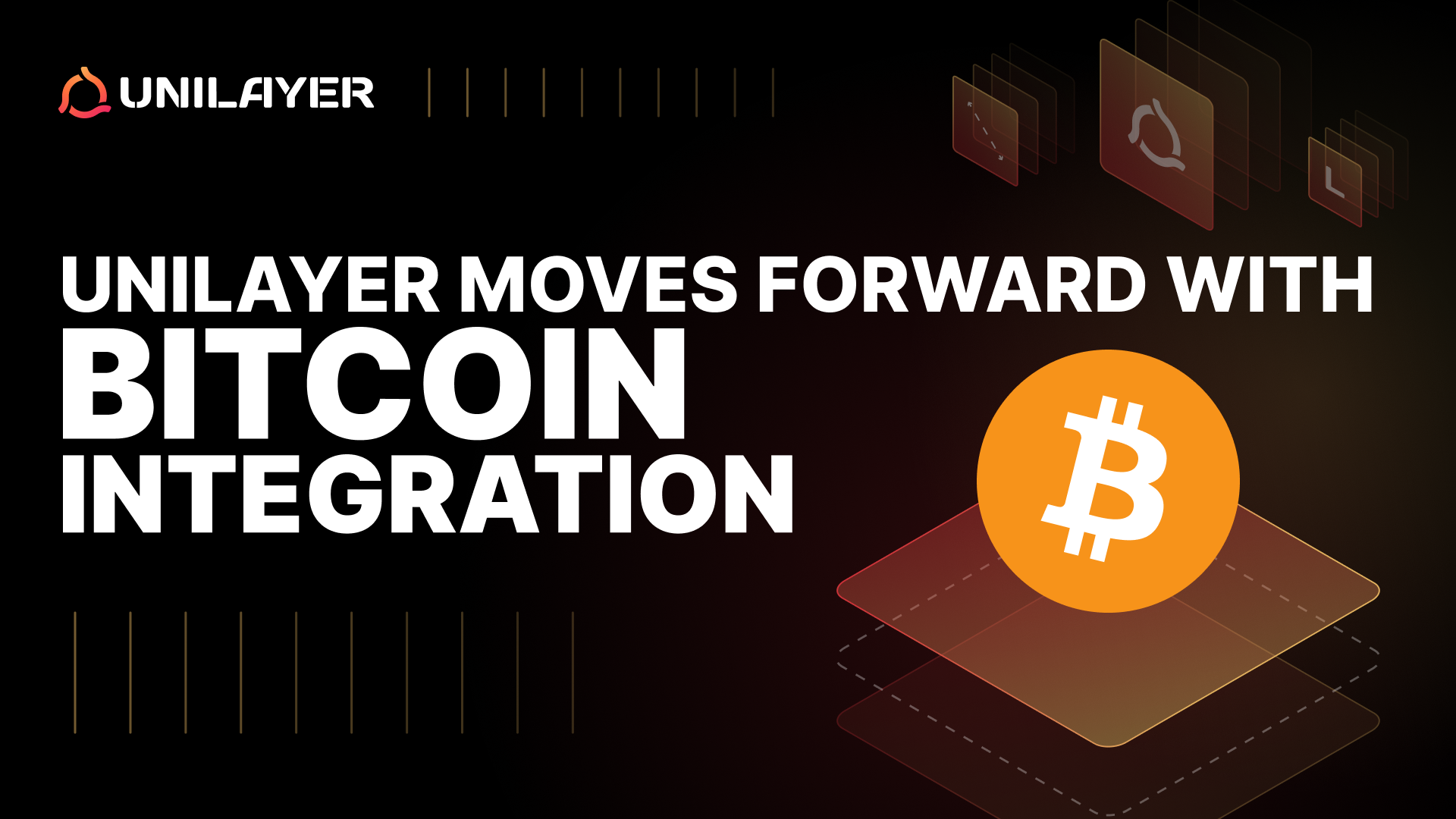UniLayer Moves Forward With Bitcoin Integration

Building on the success of the groundbreaking MetaMask integration, UniLayer is readying to incorporate Bitcoin into the UniLayer testnet network. In our previous article, we introduced Ordinals and the BRC-20 standard, discussing their future cross-chain utility on the UniLayer network. Now, let’s shift our focus to the broader implications of interoperability, both for Bitcoin and UniLayer, and the broader crypto ecosystem. Additionally, we’ll outline the architecture of cross-chain transactions on UniLayer, specifically highlighting its approaching integration with Bitcoin.
Starting with Bitcoin: UniLayer's Strategic and Principled Approach
For the vast majority of crypto users, Bitcoin is the quintessential decentralized blockchain network, even with strong competition from emerging networks with cutting-edge technology and engaged communities. As of mid-June 2023, Bitcoin boasts approximately 900,000 active addresses, more than double that of the second-largest crypto network, Ethereum. Additionally, Bitcoin maintains its position as the world's dominant network, leading in terms of market capitalization and decentralization. This dominance is expected to persist, especially as large institutional investors take steps to invest in, trade, and hold the currency.
UniLayer's primary focus is on making a significant positive impact on the blockchain industry as a whole, and this journey begins with Bitcoin. By starting with the Bitcoin network, UniLayer aims to lay the foundation for its universal, decentralized, interoperable "super network".
Once Bitcoin is integrated into the UniLayer network, we will proceed with a series of planned network integrations, including Ethereum, Near, and others, as outlined in our roadmap.
UniLayer's strategic and principled approach centers around harnessing the immense potential of Bitcoin on multiple levels. Not only does Bitcoin offer access to a vast user base, but it also represents the largest source of liquidity in the crypto ecosystem. UniLayer's MetaMask integration reflects our commitment to mass adoption, with Bitcoin serving as the cornerstone for this endeavor. Once Bitcoin is integrated into the UniLayer network, we will proceed with a series of planned network integrations, including Ethereum, Near, and others, as outlined in our roadmap.
The Principles of Bitcoin
Bitcoin's design and original intent embody a distinct ethos centered around decentralization. From this core principle arise essential values such as personal autonomy, security, and stability. These foundational tenets served as the driving inspiration behind the conception of the UniLayer network nearly three years ago.
UniLayer operates on the fundamental belief that the broader crypto ecosystem requires a decentralized and interoperable solution. In this vision, decentralization serves as the bedrock upon which the entire blockchain space should be built.
UniLayer's layer-1 network introduces an innovative approach, allowing users and DApps to conduct on-chain transactions seamlessly across different blockchains—whether it's Bitcoin to Ethereum, Ethereum to Near, or among any number of future integrated chains. This is achieved through a novel system of shared nodes, known as "Universal Nodes," which serve as validators both on their native networks and within UniLayer's expansive, interoperable network. (More insights into Universal Nodes will be provided later.)
The UniLayer team believes that Bitcoin set the standard for blockchain networks in terms of decentralization, autonomy, and security, and UniLayer aims to stay true to those principles. The UniLayer network even uses the UTXO (unspent transaction output) model, like Bitcoin.
The UniLayer team firmly believes that Bitcoin has set the gold standard for blockchain networks in terms of decentralization, autonomy, and security. UniLayer is committed to staying true to these principles. Notably, the UniLayer network uses the UTXO (unspent transaction output) model, a design shared with Bitcoin.
Smart Contracts With Bitcoin
Bitcoin, originally conceived as a universal digital currency, was not initially designed for smart contract functionality. Its primary focus was on security, rather than programmability. While the introduction of Ordinals and BRC-20 tokens mark significant milestones, enabling some smart contract-like capabilities by allowing interactions between them (as Ordinals can reference and interact with one another), Bitcoin remains far from becoming a prominent smart contract platform.
However, UniLayer's innovative solution, known as "Logix" interoperable smart contracts, is poised to revolutionize the landscape by bringing the flexibility, complexity, and scalability typically associated with Ethereum and other layer-1 networks to the Bitcoin network. Through UniLayer, DApps from various networks, including Ethereum and Near, will gain the ability to implement native smart contracts that seamlessly interact with Ordinals and BRC-20 tokens. This breakthrough will unleash a wave of new use cases, with developers and users leveraging the stability, security, and widespread acceptance of Bitcoin, along with the growing popularity of Ordinals and BRC-20 tokens, to create innovative forms of DeFi, gaming platforms, real-world asset tokenization, and more.
UniLayer simplifies and enhances the process of creating and implementing cross-chain smart contracts, by allowing a single UniLayer smart contract to coordinate multiple smart contracts across various chains. This not only reduces development costs but also significantly enhances security, providing a more robust environment for DApp developers and users alike.
Bitcoin Nodes -> UniLayer Universal Nodes
UniLayer utilizes physical-level integration, as opposed to an RPC (Remote Procedure Call), resulting in a more secure and efficient means of interoperability.
As previously mentioned, the UniLayer network relies on Universal Nodes, also known as Dual Nodes. These nodes perform an essential role by validating transactions on their native blockchain (e.g., Bitcoin) while simultaneously validating cross-chain transactions on the UniLayer network. UniLayer utilizes physical-level integration, as opposed to an RPC (Remote Procedure Call), resulting in a more secure and efficient means of interoperability.
Think of UniLayer as a "super network," an amalgamation of multiple pre-existing blockchain networks. Each new chain integrated with the UniLayer network, be it Near, Ethereum, or Cardano, inherits interoperable capabilities shared among all chains within the UniLayer network. UniLayer's universal cross-chain smart contracts (“Logix”) serve as the communication and transaction facilitators, bridging (without bridges) the diverse chains on the network.
One of the standout features that sets UniLayer apart is its strategic use of existing blockchain infrastructure to construct its interoperable network. This approach capitalizes on the strengths of established blockchain networks, supporting the overall robustness and reliability of the UniLayer ecosystem.
Bitcoin miners who choose to download and operate UniLayer's node software and actively participate in UniLayer's DPoS (delegated proof of stake) mechanism stand to reap significant benefits. They will receive separate rewards for their contributions on both the Bitcoin and UniLayer networks, in the form of Bitcoin and UniLayer's native ULR tokens. These additional rewards, coupled with the ease of integration, will serve as compelling incentives for miners, driving the growth and decentralization of the UniLayer network. As the network expands, it concurrently grows in security and stability, creating a mutually beneficial environment for all participating networks.
Crucially, UniLayer's innovative approach requires no modifications to any network's protocol, whether Bitcoin, Ethereum, Near, or any other. Individual node operators can easily download and operate UniLayer's node software, making participation straightforward and accessible.
Bitcoin Interoperability: Unlocking Liquidity, NFTs, and Cross-Chain DApps
UniLayer addresses the long-standing issue of fragmented liquidity in the cryptocurrency space. While networks like Ethereum and numerous other networks benefit from staking mechanisms and a plethora of DeFi protocols, Bitcoin's liquidity has remained largely isolated and underutilized. UniLayer, however, is poised to unleash the immense potential of Bitcoin's liquidity by enabling cross-chain DApps, allowing Bitcoin to seamlessly participate in transactions on other networks. This development comes at a crucial time, with large institutional investors poised to enter the Bitcoin market in the near future. It promises to be a game-changer for the entire crypto ecosystem, bringing us closer to widespread adoption of DeFi and decentralized currencies.
Bitcoin Ordinals will also play a pivotal role in the DeFi landscape. They will have the ability to participate in DeFi activities or be seamlessly transferred across different chains, all while retaining their complete history and autonomy within the UniLayer network. As has been demonstrated on Ethereum (and its layer 2s), Solana, and Cosmos, NFTs boast a multitude of valuable use cases, from real-world asset representation to gaming and finance. The prospect of integrating NFTs with non-fungible, Bitcoin-based assets is sure to captivate DApp developers, offering them an attractive avenue for innovation.
Furthermore, the integration of Bitcoin and the UniLayer network brings EVM-compatibility to the next level. EVM (Ethereum Virtual Machine) compatibility, which has greatly expanded Ethereum's reach and granted countless networks access to a vast pool of developers, users, and DApps, will discover a new realm of possibilities. Once Bitcoin and Ethereum are seamlessly integrated with UniLayer, decentralized applications will have the opportunity to envision entirely new visions for blockchain technology.
Looking Ahead: UniLayer's Vision for a Decentralized Future
UniLayer's integration with Bitcoin represents a powerful fusion of advantages. It integrates the worlds of security, stability, and decentralization inherent to Bitcoin with the speed, scalability, and smart contract capabilities of newer, more agile networks. This synergy is particularly advantageous for cross-chain DApps, where the Bitcoin network becomes an invaluable resource, fostering the development of robust, innovative, and diverse functionalities.
At the core of UniLayer's mission lies the steadfast belief that the future is decentralized. This guiding principle is deeply ingrained in UniLayer's layer-1 blockchain architecture, ensuring that all cross-chain transactions remain entirely on-chain. This commitment resonates with the fundamental ethos of Bitcoin, where trust, transparency, and decentralization are paramount.
As UniLayer looks ahead, its dedication to a decentralized future serves as a beacon, guiding innovation and forging a path toward a blockchain landscape where autonomy and inclusivity thrive.
Get involved today, and help shape the future of blockchain interoperability!
To learn more about UniLayer and where we’re headed, visit UniLayer.io.
To stay up to date on our MetaMask and Bitcoin integrations, and more, follow us on Twitter.
To join our growing community and talk to the team directly, visit UniLayer’s official Discord.

